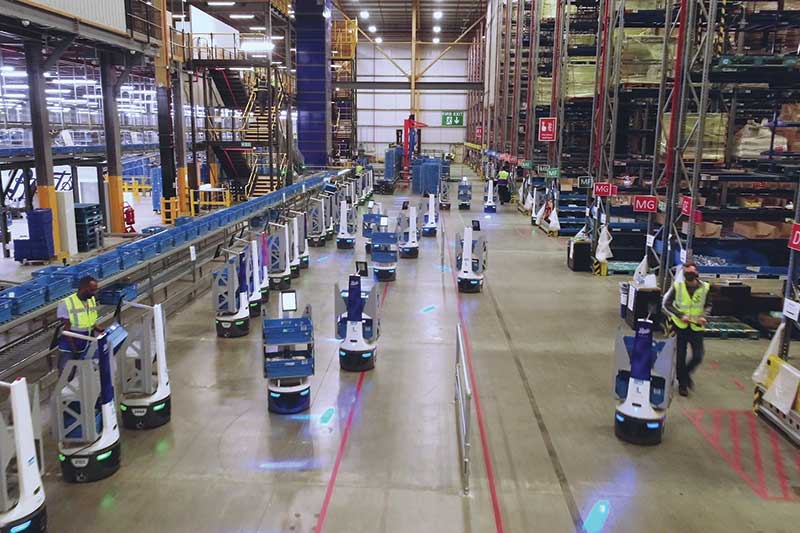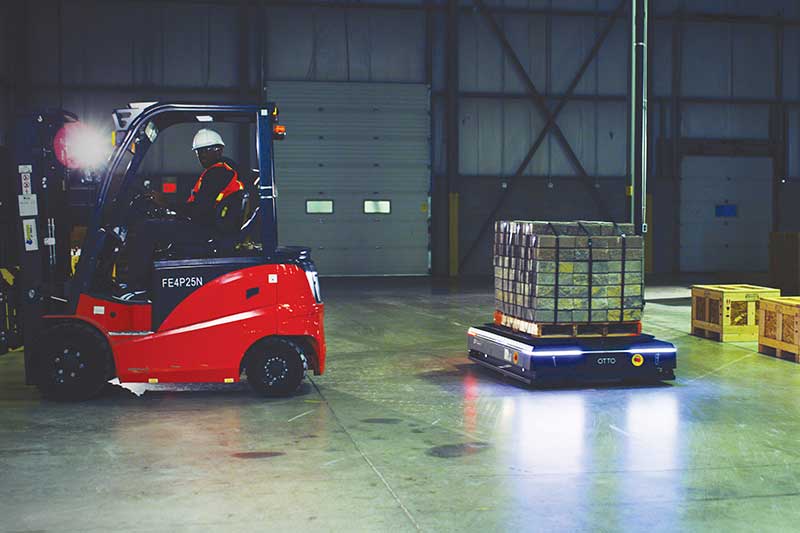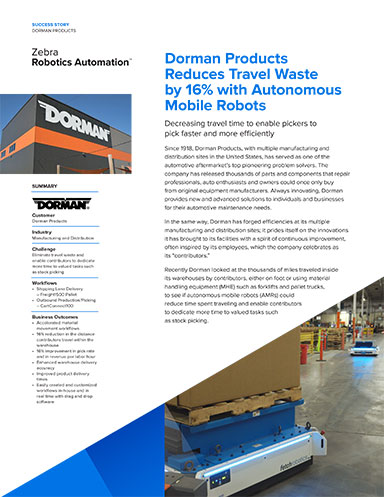Autonomous mobile robots (AMRs) on a mission
Autonomous mobile robots are the current leading figure in the move to mobile automation. Their mission is quite simple: Reduce the cost of shipping everything.
Rest assured, no matter how many autonomous mobile robots (AMRs) you have already seen, you’ve only scratched the surface. And if that feels a little overwhelming, it’s more than OK. You won’t need therapy.
Go back to the early 2000s and all you basically had was Kiva. Remember those pioneering orange bots that carried goods on shelves to pickers? Amazon’s purchase of Kiva did not deter the proliferation of AMRs in manufacturing and distribution. Anything but.
Fast forward to 2016 or so, and we had probably 20 AMR suppliers in the market, says Kait Peterson, senior director of product marketing at Locus. Now she estimates there are more than 200 suppliers.
Or as David Northrup, director of product management at OTTO Motors by Rockwell Automation, says, “there’s now a sea of AMR manufacturers we didn’t even know a year ago.”
On one side of the AMR equation, “we are well past the early adopter stage,” says Northrup. He estimates tens of thousands of AMRs are probably deployed worldwide.

These range from pilots to full-fledged systems, explains Akash Gupta, CEO and co-founder of GreyOrange, of fewer than 50 bots to ones with 200 to 700 bots. Gupta says his company alone now has 10,000 AMRs at more than 70 installations worldwide.
Functionally, we are well past the stage of the early systems that carried racks and shelves of goods to a picker. Those systems are still very mainstream. But now we’ve got systems that bring totes of goods to pickers. And ones that support picker-to-goods inventory flow. Others do sortation and some move pallets.
In fact, Gupta identifies several other types of early development AMRs. These include ones with robotic arms for pallet, case and each handling. There are also shuttle systems, loader/unloader systems and drones.
Gupta finishes off the list with humanoids. You may have seen what Amazon recently announced about a new type of AMR from Agility Robotics in one of its warehouses.
As Bloomberg’s Businessweek reported, these are 5-foot, 9-inch robots that resemble “a human, walk like a bird and has glowing white eyes. Called Digit, the machine is configured for one basic task: plucking empty yellow bins off a shelf and ferrying them several feet to a conveyor.” All day long.
Now you can exhale. But don’t get too comfortable. AMRs are not happening in a vacuum.
Mobile automation
Yes, a lot of distance exists between small, floor-running bots and drones and humanoid robots. But all have two characteristics in common.
They are all automation. And they are all mobile.
Welcome to the age of mobile automation. AMRs are just the advanced brigade. But they are not the first. To claim that would slight automatic guided vehicles (AGVs).
“People should not move to AMRs and walk away from what they already learned and know from using AGVs,” says Christian Siefen, senior robotics engineer at ResGreen Robotics. “Instead, a move to AMRs is a chance to blend and learn what is already known from using AGVs,” he adds.
Siefen continues to explain that while AGVs most typically follow fixed paths, AMRs autonomously determine their own route. While that fundamentally changes warehouse and manufacturing floor interactions between the automated vehicles, fixed objects and people, the presence and impact of mobile automation is much the same.
That said, the current strong interest in AMRs is the result of a fundamental shift in materials handling.
“What has been an interest in automation is changing to a commitment to automation,” explains David Griffin, chief sales officer at Seegrid. Just as important, that commitment is extending from operating managers to the C-suite.

In other words, AMRs are here to stay and with good reasons.
Just the name mobile automation says we are in a new age. Only the rare facility today does not have fixed equipment, often with a range of automated systems. Everyone expresses contempt for their inflexibility but has built a career on making fixed automation work. But that is changing with AMRs. Blend and learn.
While mobile automation is the form factor, operational improvements are the core of the attraction.
“It’s all about using the outcome of employing bots. Quite simply, AMRs reduce the cost per unit shipped to stores and consumers directly,” explains Gupta.
Contributors here include 99% uptime and increased number of on time shipments, Gupta adds. “Ultimately, it comes down to shipping X units every day with X units of technology,” says Gupta.
A typical 18-month return on investment also ensures a rapid payoff for the technology. Typical operating life for a bot, he says, is 7 to 10 years.
Gupta continues to say that selecting the right bots and software for a particular operation is about “finding the right balance of cost and abilities of the bots. It is not about the cheapest upfront cost of each AMR.”
What’s the mission?
With that said, we can move on to finding the right AMR system for your operation. Remember, AMRs are enablers not replacers, says Peterson of Locus.
She continues that AMRs not only enable productivity gains but improve workplace quality and worker ergonomics.
In other words, determine early on the desired mission of an AMR fleet, she adds. What do you want it to do? How many units does it need to handle in a given period of time?
In other words, says Griffin, it is critical to match the abilities of the bots to an operation’s needs.
This requires understanding how inventory already flows in your facility, and how that flow differs during peak and non-peak times. And going back to the goods-to-picker and related scenarios, how exactly do you want that flow to work going forward?
Gupta adds that it is typically not in your best interest to consider just one type of AMR. “There are multiple technologies that meet multiple needs with various form factors and payload capabilities,” he adds.
This may require conversations with several different AMR suppliers given the range of bot capabilities. As Northrup of OTTO points out, no single company can meet all needs.
This leads us into mixed supplier fleets, an uncommon feature today. But all experts interviewed for this story see mixed fleets as the future. Details in a few.
About now, the word scalability works into the conversation. This applies to three tranches: pilots; live systems; systems with more than one type of AMR to multiple types; and AMRs in multiple facilities.
From interviews, the general rule of thumb for a pilot system is 40 or fewer bots. The size of live systems, of course, is entirely dependent on the mission of the system. And the numbers here can range from 100 to several hundred or even 1,000.
There is no recommended number of bots for any particular system. The numbers offered here are merely to indicate that AMR systems are highly scalable depending on the application.
Making it all work
Connectivity. Safety. Those two words are core to the future success of AMRs.
We already brought up connectivity and promised more. Here you go.
AMR fleet management today rests almost entirely on a fleet with bots from a single manufacturer. But a mix of manufacturers is inevitable as you and others build fleets with a range of individual missions.
The challenge is how do you get these machines to talk to each other? Their connectivity is a cornerstone of future systems, explains Peterson of Locus.
Several of the suppliers contacted for this story are working on this challenge. Advances will come step wise from the number of other suppliers connected to the degree of interoperability possible across the fleet.
Simultaneously, industry standards will be part of the solution, says Siefen of ResGreen. He cites two communication standards, VDA 5050 in Europe and the MassRobotics Standard in the United States.
The former focuses on one fleet management system for both AGVs and AMRs from multiple manufacturers. The latter focuses on sharing basic data across the network.
“Since the two standards are not conflicting protocols, a mobile robot should be able to use both,” Siefen says.
Both standards are roughly 30% of the way through their development, says Siefen. “And while it will be years until these standards are standard, there is still enough missionary work to do with AMRs before interoperability will be a critical capability.”
Another capability already essential is safety. “Safety is No. 1 on everyone’s list and has been for a long time,” says Seegrid’s Griffin.
Central to the safety of AMRs are LiDar, also known as light emitting and detection technology, and safety scanners, says Siefen.
In a nutshell, LiDar uses a laser to scan what’s in the path of the AMR. This scan is then processed in milliseconds and the AMR’s onboard navigation system makes a decision to proceed, stop, reroute or make another movement decision.
Siefen says to be aware of several key points here. These include: the maximum stopping distance at maximum load and speed; pinch points where people can get caught between the AMR and a fixed object, and; clearly identified lanes for AMR travel. “Humans in the facility need some way to know where it’s safe to walk or not walk,” adds Siefen.
While AMRs are not ubiquitous, they are certainly leading edge in the advancement of mobile automation. As their capabilities continue to expand so will your options to maximize their effectiveness in your operations.












